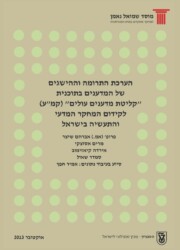בשני העשורים האחרונים הועסקו, ועדיין מועסקים במוסדות אקדמיים בישראל, אלפי מדענים עולים במסגרת תוכניות קליטה שונות (שפירא, גלעדי וקמ”ע). התקציבים להעסקת מדענים אלה הועמדו ברובם ע”י משרד הקליטה, באמצעות היחידה לקליטה במדע, ומקורות אחרים פנים- וחוץ-אוניברסיטאיים. המחקר הנוכחי מתמקד בקבוצת המדענים הבכירים בלבד, מדעני קמ”ע. במחקר קובצו נתונים ביחס לאוכלוסיה זו שנותחו במגמה לכמת ולהציג את פעילויותיהם של מדעני קמ”ע ורישומם, בחתכים שונים, על המחקר, ההוראה ופעילויות נוספות במסגרות אקדמיות מחקריות ובתעשיה. הנתונים נאספו מכלל האוניברסיטאות בישראל בהן הועסקו, ועדיין מועסקים, מדעני קמ”ע.
מטרת המחקר לאמוד את תרומותיהם והישגיהם של המדענים בתוכנית קמ”ע, שנועדה להבטיח בטחון תעסוקתי למדענים בכירים מצטיינים עד הגיעם לגיל פרישה, ע”י מינויים למשרות מחקר במוסדות מחקר.
בין הנושאים שנבדקים כלולים: סטטיסטיקה (מספרי מדעני קמ”ע בתוכנית בעבר ובהווה, השכלתם, תחומי התמחותם, מגדר, גיל, שנות שהייה באקדמיה (כולל שהייה במסגרות קליטה אחרות), פילוח לפי אוניברסיטאות, וכו’), תקציבים, השתתפות מדעני קמ”ע במחקרים, פרסום מאמרים וספרים, הגשת פטנטים, פיתוח מעבדות הוראה ומחקר, זכייה בפרסים, יזום חברות הזנק ותרומותיהם לתעשיה בישראל, ועוד.
המחקרימתייחס להיבטים הפיננסיים של התוכנית אשר ניזומה בשנת 1998 ע”י ממשלת ישראל, כדי לאפשר המשך קליטת הבכירים בין המדענים העולים באוניברסיטאות, במכללות ובמוסדות מחקר. מטרת התוכנית הינה לאפשר קליטה ממושכת של מדענים עולים שסיימו את תוכנית גלעדי. מרבית משתתפי התוכנית מועסקים בקבוצות מחקר במוסדות להשכלה גבוהה ומיעוטם במכוני מחקר או בבתי חולים. המוסדות המעסיקים את המדענים מתחייבים להעסיקם בדרך כלל עד הפנסיה. בשלב ראשון מובטחת העסקתם לשלוש שנים.
מטרות נוספות הן: שדרוג מעמדם האקדמי של מדענים אלה והעסקתם בדרגות חוקרים ובתנאי שכר מקבילים לתנאים של הסגל האקדמי הבכיר באותו מוסד וכן, צבירת משאבים שישמשו בבוא העת לתשלומי גמלאות.
התוכנית מומנה ע”י המשרד לקליטת העלייה באמצעות המרכז לקליטה במדע בשיתוף עם הוועדה לתכנון ותקצוב של המועצה להשכלה גבוהה והגופים המעסיקים. במסגרת המחקר נדגמו 338 מדענים עולים מתוך 680 שלקחו חלק בתוכנית קמ”ע החל משנת הפעלתה ב-1998 ועד לסוף 2011. העלות הכוללת של מימון תוכנית קמ”ע בשנים אלה מוערכת כמיליארד וחצי שקלים. משך זמן השהייה הממוצע של המדענים בתוכנית היה כ – 9 שנים.


